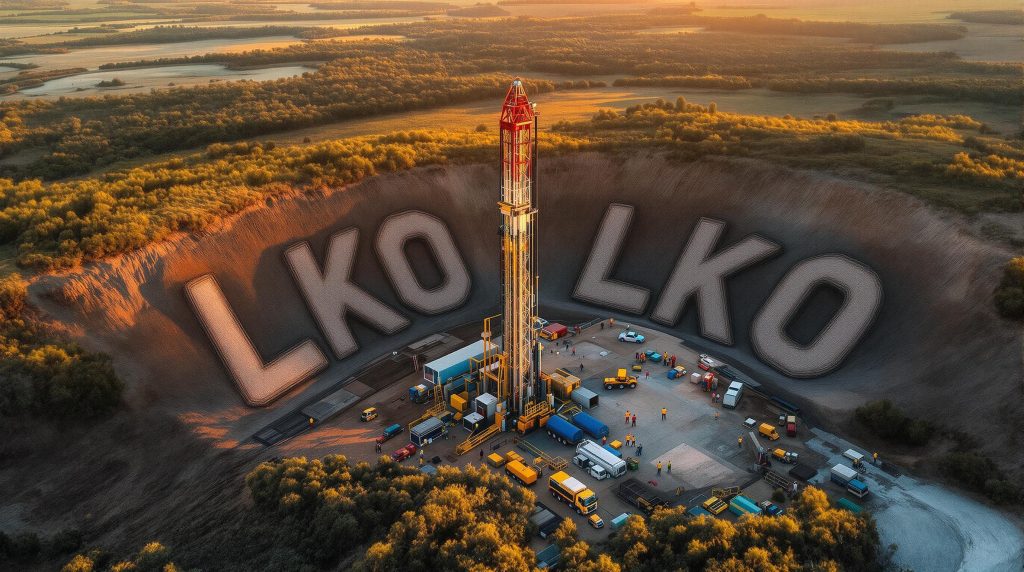Lakes Blue Energy Encounters Drilling Challenges at Wombat-5 Well
Lakes Blue Energy (ASX: LKO) has reported operational challenges at its Wombat-5 side-track well in Victoria's Gippsland Basin, with drilling progress temporarily halted due to technical complications. The lakes blue energy Wombat-5 drilling challenges represent a significant hurdle for the company as it pursues its exploration program in this resource-rich region.
Drilling Operations Halted After Equipment Issues
The company's latest update reveals that after 13 days of drilling operations, the Wombat-5 side-track-1 (ST-1) well has reached a depth of 1,091 meters but is currently facing significant technical difficulties. The operation encountered problems when the mud pumps lost suction, preventing proper circulation of drilling mud in the hole.
This complication has resulted in the Bottom Hole Assembly (BHA) becoming stuck at approximately 1,088 meters. Despite attempts to free the equipment using jarring techniques, the company has been unsuccessful and now plans to sever and retrieve the drill-string above the sticking point.
Key well statistics:
- Current depth: 1,091 mRT (measured depth)
- Last 24-hour progress: 0 meters
- Current formation: Latrobe Group
- Target formation: Strzelecki Formation at 1,360 mRT
Understanding Drilling Complications
When drilling operations encounter issues like those at Lakes Blue Energy's Wombat-5 well, it's important to understand what these technical challenges mean for the project. The loss of suction in mud pumps represents a significant operational hurdle in drilling operations.
Drilling mud serves multiple critical functions during well construction:
- Removing rock cuttings from the well
- Cooling and lubricating the drill bit
- Maintaining pressure control within the wellbore
- Stabilising the walls of the hole
When circulation is lost, as in the case of the Wombat-5 drilling challenges, the drilling team loses the ability to perform these essential functions. Without proper mud circulation, cuttings can accumulate around the drill bit and lower portion of the drill string, increasing the risk of the equipment becoming stuck—precisely what has occurred at the Wombat-5 well.
The Bottom Hole Assembly refers to the components at the lower end of the drill string, including the drill bit and other specialised tools designed for specific drilling functions. When a BHA becomes stuck, operators typically attempt to free it using jarring techniques—essentially creating mechanical impacts to loosen the stuck assembly. In this case, Lakes Blue Energy reports these attempts have been unsuccessful.
Recovery Plan and Path Forward
Lakes Blue Energy has outlined a clear recovery strategy to address the Wombat-5 drilling challenges:
- Sever and retrieve the drill-string above the sticking point
- Set another cement plug to enable a new side-track around the stuck pipe
- Resume drilling toward the 7" casing point at approximately 1,548 mRT
The company reports that necessary equipment for this operation has been sourced and is expected to arrive on site, with retrieval operations planned to commence shortly. Importantly for investors, Lakes Blue Energy has noted that insurance coverage is in place to cover most costs associated with the lost drill-string.
"Any future drilling is subject to a review of the Contractor's report by the Company," states the official ASX announcement authorised by the Lakes Blue Energy Board.
The company has reported that their contractor has continued to investigate the problem and considers that electrical and/or mechanical failure of the mud pumps and ancillary surface equipment did not contribute to the loss of suction. This investigation is expected to be completed and reported to Lakes Blue Energy.
Financial Implications for Investors
While operational setbacks like the Wombat-5 drilling challenges are not uncommon in drilling operations, they can impact project timelines and potentially increase costs. However, three factors mitigate investor concerns:
- Insurance coverage for the majority of lost equipment costs
- No reported health, safety, or environmental incidents (0 LTIs)
- Clear path forward with equipment already sourced for recovery operations
From a financial perspective, the insurance coverage for the lost drill-string components represents prudent risk management by Lakes Blue Energy. While delays in operations can impact project economics, the company's proactive approach to resolving the issue demonstrates operational competence in the face of technical challenges.
Understanding Gippsland Basin Gas Exploration
The Wombat-5 well is part of Lakes Blue Energy's broader exploration program in the Gippsland Basin, one of Australia's most significant hydrocarbon provinces. The basin has historically been a major source of oil and gas production, with ongoing exploration targeting both conventional and unconventional resources.
The current Wombat-5 drilling operation aims to reach the Strzelecki Formation at a depth of 1,360 mRT (true vertical depth). This formation is of particular interest to gas explorers in the region due to its potential hydrocarbon-bearing properties.
The drilling challenges at Wombat-5 highlight the technical complexities inherent in deep drilling operations. While the current depth of 1,091 meters represents significant progress, the operational issues demonstrate why exploration drilling carries both technical and financial risks that companies and investors must factor into their expectations.
Why Investors Should Continue to Monitor Lakes Blue Energy
Despite the temporary setback with the lakes blue energy Wombat-5 drilling challenges, Lakes Blue Energy remains positioned to advance its Gippsland Basin gas exploration program. The company's response to the drilling challenge demonstrates operational resilience and risk management capabilities.
For investors with exposure to the Australian energy sector, this development represents a typical operational challenge rather than a fundamental issue with the project's viability. The company's stated intention to continue drilling after recovery operations and contractor review indicates confidence in the underlying project.
The Gippsland Basin continues to be one of Australia's premier hydrocarbon provinces, and successful development of assets in this region could provide significant value to Lakes Blue Energy shareholders as Australia faces increasing domestic gas supply challenges.
Investors should watch for forthcoming announcements regarding:
- Successful retrieval of equipment
- Results of the contractor's investigation
- Commencement of side-track operations
- Resumption of drilling toward target depth
These milestones will be critical indicators of the project's progression timeline and Lakes Blue Energy's operational capabilities in addressing the Wombat-5 drilling challenges.
Drilling Risks in Resource Exploration
The current situation at Wombat-5 illustrates the inherent risks associated with drilling operations. Even with modern technology and experienced crews, subsurface operations involve numerous variables that can lead to technical complications.
Common drilling risks include:
- Equipment failures
- Loss of circulation
- Wellbore instability
- Stuck pipe incidents
- Formation pressure management challenges
Professional drilling operations incorporate risk management strategies including:
- Comprehensive pre-drill planning
- Careful selection of equipment and contractors
- Insurance coverage for potential losses
- Contingency plans for technical challenges
- Regular operational reviews
Lakes Blue Energy's approach to the current challenge demonstrates many of these professional risk management practices, particularly in having appropriate insurance coverage and a clear plan for recovery operations.
As the company works to overcome the Wombat-5 drilling challenges, investors should maintain realistic expectations regarding timelines while recognising that such technical issues are a normal part of exploration activities rather than exceptional events. Similar technical challenges have been observed in other exploration projects, such as when Sunshine Metals intercepted promising gold-silver veining at their Tigertown project.
Furthermore, the exploration sector has seen numerous companies face and overcome similar obstacles. For instance, ZMI recently secured drilling approval for a massive untested anomaly at Mt Clere, while S2 Resources launched a major multi-project drilling campaign across Australia despite similar operational challenges.
The perseverance through drilling complications often leads to significant discoveries, as demonstrated when Hammer Metals unveiled two major gold-copper discoveries in North Queensland. In addition, companies like Sunshine Metals have utilized geophysical surveys to identify potential sulphide deposits, highlighting the various approaches companies take to overcome exploration hurdles.
Looking to Spot the Next Major ASX Resource Discovery?
Discovery Alert's proprietary Discovery IQ model instantly notifies investors about significant mineral discoveries on the ASX, helping you identify potential opportunities before the broader market reacts. Explore why these discoveries can generate substantial returns by visiting the Discovery Alert discoveries page and position yourself ahead of other investors.




